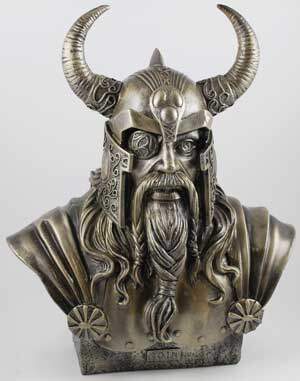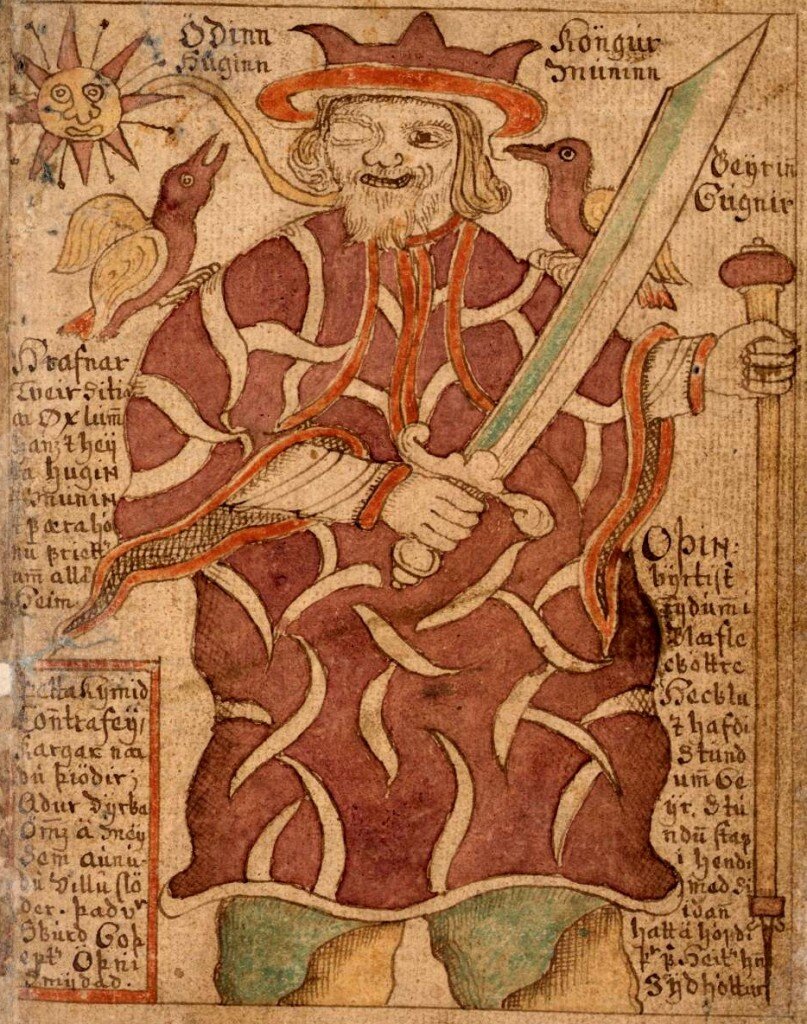Odin
Odin (Old Norse: Óðinn) is the god of wisdom, poetry, death, necromancy, divination, and magic. Said to have created the Runes.
Son of Bor and the giantess (jötunn) Bestla, Odin is the chief of the Æsir and the king of Asgard. He is married to the goddess Frigg, and is the father of the gods Thor, Baldr, Höðr, Víðarr, and Váli.

Odin incites otherwise peaceful people to strife with what, to modern tastes, is a downright sinister glee. His attitude is not far from Nietzsche’s dictum,
“You say it is the good cause that hallows even war? I say unto you: it is the good war that hallows any cause.”
This ecstasy that Odin embodies and imparts is the unifying factor behind the myriad areas of life with which he is especially associated: war, sovereignty, wisdom, magic, shamanism, poetry, and the dead.
Who is Odin?
…is one of the most complex and enigmatic characters in Norse mythology, and perhaps in all of world literature. He’s the ruler of the Aesir tribe of deities, yet he often ventures far from their kingdom, Asgard, on long, solitary wanderings throughout the cosmos on purely self-interested quests. He’s a relentless seeker after and giver of wisdom, but he has little regard for communal values such as justice, fairness, or respect for law and convention. He’s the divine patron of rulers, and also of outlaws. He’s a war-god, but also a poetry-god, and he has prominent “effeminate” qualities that would have brought unspeakable shame to any historical Viking warrior. He’s worshiped by those in search of prestige, honor, and nobility, yet he’s often cursed for being a fickle trickster.
Along with Freya, he’s one of the two greatest practitioners of shamanism amongst the gods.
His shamanic spirit-journeys are well-documented. The Ynglinga Saga records that he often “travel[s] to distant lands on his own errands or those of others” while he appears to others to be asleep or dead. Many say the roots of Santa Claus belong with Odin’s travels, travelling across the skies to collect the souls of the dead at that specific time of the year.
When Roman writers spoke of the gods and goddesses of other peoples, they generally tried to identify them with deities from their own religion. When they mentioned Odin, they glossed him as Mercury, the Roman psychopomp (the divine figure who guides those who have just died from the realm of the living to that of the dead, and, in due time, back to the land of the living again). This is significant, because it shows that Odin’s associations with death were seen as being even more significant than his associations with war, or else he would have been glossed as Mars.
Odin, like shamans all over the world, is accompanied by many familiar spirits, most notably the ravens Hugin and Munin, the wolves Geri and Freki, and the valkyries.
Odin presides over Valhalla, the most prestigious of the dwelling-places of the dead. After every battle, he and his helping-spirits, the valkyries (“choosers of the fallen”), comb the field and take their pick of half of the slain warriors to carry back to Valhalla. (Freya then claims the remaining half.)
He was a frequent recipient of human sacrifice, especially of royalty, nobles, and enemy armies. This was generally accomplished by means of a spear, a noose, or both – the same manner in which Odin “sacrificed himself to himself” (Old Norse gefinn Óðni, sjálfr sjálfum mér) in order to acquire knowledge of the runes. A common – and chilling – way of securing his favor in battle was to throw a spear over one’s foes, sacrificing them to the god with the cry, “Odin owns ye all!”
The shaman must typically undergo a ritual death and rebirth in order to acquire his or her powers, and Odin underwent exactly such an ordeal when he discovered the runes.
His mastery of necromancy, the magical art of communicating with and raising the dead, is frequently noted.
While there are several reasons Odin maintains this commerce with the dead, including his desire to learn what knowledge and wisdom they possess, the most significant reason is his dread-driven desire to have as many of the best warriors as possible on his side when he must face the wolf Fenrir during Ragnarok – even though he knows that he’s doomed to die in the battle.
The other main form of Germanic shamanism is contained within the magical tradition known as seidr, of which Odin and Freya are the foremost divine practitioners. In traditional Germanic society, for a man to engage in seidr was effectively to forsake the male gender role, which brought considerable scorn upon any male who chose to take up this path. As the sagas show, this didn’t stop some men from practicing seidr anyway. However, even Odin wasn’t exempt from such charges of “unmanliness,” and was taunted for adopting the feminine traits and tasks that form part of the backbone of seidr. Saxo, in the passage on Odin’s exile alluded to above, relates that “by his stage-tricks and his assumption of a woman’s work he had brought the foulest scandal on the name of the gods.”
Why the missing eye?
One of the most striking attributes of his appearance is his single, piercing eye. His other eye socket is empty. It is said, the missing eye was sacrificed for wisdom.

The general story goes, Odin ventured to Mimir’s Well – a shadowy being whose knowledge of all things was practically unparalleled among the inhabitants of the cosmos. He achieved this status largely by taking his water from the well, whose waters impart this cosmic knowledge.
When Odin arrived, he asked Mimir for a drink from the water. The well’s guardian, knowing the value of such a draught, refused unless the seeker offered an eye in return. Odin – whether straightaway or after anguished deliberation, we can only wonder – gouged out one of his eyes and dropped it into the well. Having made the necessary sacrifice, Mimir dipped his horn into the well and offered the now-one-eyed god a drink.
An Interpretation
The most general and obvious message of this tale is that, for those who share Odin’s values, no sacrifice is too great for wisdom.
We would love more information on how you work with Odin. Feel free to email us or share in the comment section below.
Sources:
- Snorri Sturluson. Ynglinga Saga 7. In Heimskringla: eða Sögur Noregs Konunga.
Turville-Petre, E.O.G. 1964. Myth and Religion of the North: The Religion of Ancient Scandinavia.
Nietzsche, Friedrich. 1954. Thus Spoke Zarathustra: a Book for All and None. In The Portable Nietzsche. Edited and translated by Walter Kaufmann.
Bauschatz, Paul C. 1982. The Well and the Tree: World and Time in Early Germanic Culture.
Web: https://norse-mythology.org/tales/why-odin-is-one-eyed/
